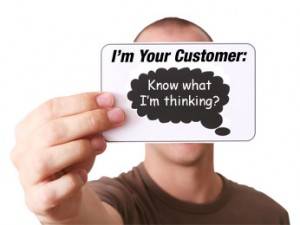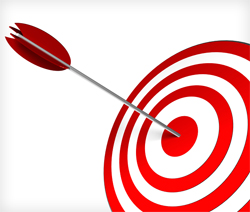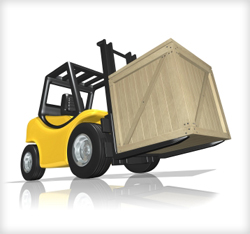The Key to Tradeshow Exhibit Success: Location, Location, Location
When you’re planning for the upcoming year of trade shows, it’s important to remember that the location of your booth at trade shows can be key to getting the maximum amount of traffic.  Lots of traffic can equate to a higher number of qualified sales leads, which you need to justify the expense of attending these shows.
Lots of traffic can equate to a higher number of qualified sales leads, which you need to justify the expense of attending these shows.
The first step is to plan for the trade show early. When you book early, you’ll have more options to choose from for your booth location. If you wait until the last minute, you’ll be limited to choosing from whatever booth spots are not sold. The only plus of waiting: you might be able to find out in advance who your neighboring exhibitors will be. If a show doesn’t sell out, by booking later, the show organizers might offer that accompanying booth—if vacant—for free or for a greatly reduced price just to fill it.
If a particular show is a success for you, sign up and reserve your spot for the following year’s event while at the event or shortly thereafter, which might get you a better location and better deal too. Keep in mind that if you are a returning exhibitor, the event management’s sales folks want you back. Use this as a bargaining chip in your negotiations for next year’s booth rate and location.
So what are the prime locations when choosing your booth location? Let’s take a look at a few of the primo spots that exhibitors crave.
Close to the exit from the restrooms. You might balk at getting seated near the restroom at a restaurant, but tradeshows are an exception. Everyone eventually has to go to the bathroom and as they leave, they are often in strolling mode and more likely to stop.
Adjacent to food kiosks and/or Internet cafes. Be the first booth they see after they grab that cup of coffee, eat that bagel or check their email. Once their hunger is sated or their caffeine withdrawal has ebbed, they will be ready to give you their full, undivided attention.
Close to the entrance/exit of the exhibit hall. It’s guaranteed that everyone will have to walk by your booth multiple times a day. Be the first booth they see when they enter the hall, before they are worn out from hours of schlepping up and down the aisles.
End of aisles or on back walls. People often look to see how long aisles are and stop to get their bearings before they embark down an aisle. Seize this opportunity to grab their attention.
Which Trade Show is Right for you?
It is an age old question – should we exhibit? This question surfaces on a regular basis in all marketing departments. There are certain shows, based on their great performance in the past, that are no-brainers. But there can be others which you may not know much about.
 Ask Customers and Prospects about the Trade Shows They Attend
Ask Customers and Prospects about the Trade Shows They Attend
The first point is to simply ask others about the trade shows that they like and attend. Make it a habit to ask customers and prospects alike “which trade shows do you attend?”
- Which is the “best” one for finding new products?
- How are the shows different and what makes them different?
- If they often attend more than one – which one is most important?
- Which one would they skip if they had to choose?
- Which show(s) have caught their attention, but haven’t yet made a priority?
You might consider conducting a short survey that can be sent out to your prospects and customers to solicit their responses. There are many free survey tools available to use, like Survey Monkey, Zoomerang, and others.
Talk with the Trade Show Organizer
The show organizer’s job is to be an expert on who attends their events. Typically they have concrete, measurable registration surveys and audits for you to view. Initially, you can review their prospectus; then, if it looks like a fit for you, call them directly. They know that a successful show is predicated on the right buyers finding the right vendors. Consequently, they make a science out of profiling their customers, and you should too.
To begin profiling your customer, start with these questions: Who do you want to attract to your exhibit booth? Who are the ideal customers for your product and/or service and what is important to them? Depending on whether your market is, business to consumer, or business to business, the criteria will be different. Regardless of the specific terms, you will need to define your customer. The broad range of data categories are: demographics (who is my customer), psychographics (what do they do), behavioral (how do they do it) and causation (why they do what they do). According to Barry Siskind in an article called The Right Place to Exhibit – A Strategic Approach, “causation is the sum total of all the demographic, psychographic and behavioral data you have accumulated. It matches up your features and benefits with your customers’ perception of their importance.”
As you profile your target audience, you can ask questions to find out where they are and the best way to reach them. Given that shows have various geographic focuses (regional, national or international), you will want to choose those ideally suited to both you and the audience you serve. Ultimately, you have plenty of choices, though finding the right trade show can be challenging. “The right show is a blend of audience, cost and logistics. Good event selection is a solid base upon which the rest of your exhibit program is built,” Siskind reminds us.
Resources for Locating Trade Shows
If you need to look up a show, here are several online resources for you.
Events in America: www.eventsinamerica.com
Trade Show News Network: www.tsnn.com
The Trade Show Calendar: www.thetradeshowcalendar.com
Selecting the right trade show is just the beginning of the process.
Trade Show Targeting – What Makes My Customer Tick?
Understanding the business concerns, issues and problems of your prospects and customers is paramount in crafting a marketing message. This message is a critical component of your trade show plan, as well as your business marketing plan as a whole. However, it is not easy to tap into their minds. This process requires market research to effectively derive their characteristics for purchasing. During the last few years, the buying patterns have changed and possibly your customer persona has evolved into a totally different person. Keeping up with the shifts and changes can be difficult.
 One way to tune into the mindset of a customer base is using focus groups. They can be quite effective in uncovering the thought processes and preferences of an audience. If you are not familiar with this research form, let me provide some additional information.
One way to tune into the mindset of a customer base is using focus groups. They can be quite effective in uncovering the thought processes and preferences of an audience. If you are not familiar with this research form, let me provide some additional information.
What are Focus Groups?
Focus Groups are great at capturing the attitudes and opinions of a “selected” group(s) of individuals. The moderator poses questions to the group affording the participants the opportunity to share their views. It is important to remember that these groups are qualitative in nature and sometimes would need to be followed up with a quantitative research project to ensure statistical reliability.
However, the catalytic nature of focus groups can provide direction as to what the next steps should be in the evolution of the idea being tested.
In essence – you are testing ideas or communication messages to determine if they are on target or not. Customer and prospect language or what they “hear” can be TOTALLY different from what you are communicating. Being in tune with your audience can spell s-u-c-c-e-s-s.
Using Online Research to Probe the Minds of Your Customer
Rather than in-person focus groups, participants are recruited for the online experience. Typically, 12 – 15 are secured and they commit to the process.
- A research moderator posts questions over the course of several days as the conversation evolves and probes respondents for details and clarifications when needed.
- Respondents can log in and answer each days’ questions whenever it’s convenient for them – some folks are online at the crack of dawn, some like to log in and take a break during work hours and others log in after dinner is done and the kids are in bed. Being convenient means that respondents can take time to think about the questions and provide thoughtful answers.
- Clients are able to log in and observe the discussion and leave private messages for the moderator regarding comments they would like clarified or suggestions for new topics.
- They last over a three-day period which allows for reflection on questions answered and possible modifications to the moderator’s script.
The participants interact with each other and the moderator as they provide their valuable insights to questions posed. In the process, all sorts of light bulbs are illuminated and most often a new, enhanced direction is revealed.
Mike Courtney from Aperio Insights shares these insights when considering online focus groups to determine your trade show messages.
Most likely there is a current marketing communications campaign going on within your company. Does your audience really understand the campaign or is there some confusion on the message you are attempting to convey?
Or you can assess whether your prospects deem you as a trustworthy resource. Or do they trust your competition more than you?
Have the prospect or customer “explain” your services or products to the moderator of the online focus group. Are they accurately defining your offering? Note: this question can be quite revealing as to how far off the mark your audience is to what your product does or what your marketing message is.
One other word of note – research can beget research. The more you uncover – additional questions will surface.
As you research and make your trade show marketing plan, consider taking the pulse of your customers. If you can translate their heartbeat (the business issues) into your marketing message, a match is made and most likely you will have a new customer.
A Perfect Tradeshow Vendor Relationship
Finding the perfect vendor to support your tradeshow program can be challenging, and there is no one-size-fits-all solution, but with the right things in mind, you can hit your target. As with any other decision, the preparation you put into it will greatly affect your level of success.
 Typically, the decision for an exhibit supplier is made during the purchase of a new display. It may seem logical that the company that built the display would be the best choice to manage it. Sometimes that may be true, but often the problem is that the companies that do the best job of design and presentation are not always the best at program management. Their company’s focus might be on designing and building new exhibits, leaving program management to take a back seat.
Typically, the decision for an exhibit supplier is made during the purchase of a new display. It may seem logical that the company that built the display would be the best choice to manage it. Sometimes that may be true, but often the problem is that the companies that do the best job of design and presentation are not always the best at program management. Their company’s focus might be on designing and building new exhibits, leaving program management to take a back seat.
A good start in your search is determining how much help you will need, and the size of your program:
- Pharmaceutical companies might exhibit in over 100 shows per year, not including other events that are a large part of their face to face marketing. Auto manufacturers exhibit in 65 or more shows in the span of a few months. These types of companies usually prefer to deal with the largest exhibit companies.
- Companies that participate in fewer shows each year in smaller configurations may not get the level of service that they need from a huge exhibit company, and often end up being the proverbial “small fish in a big pond.”
In order to find the best match for your needs, give some thought to how much support you will need from your exhibit company. Some companies need only basic assistance, such as storage, preparation and minor repairs. Others rely more heavily on an exhibit company to handle the entire show including show services, graphic design, shipping, etc. Be sure to consider how important your scale of business will be to your new vendor and whether you will have access to senior management in the event that problems occur.
While experience in your specific industry is a valuable thing, use caution in looking for a company that has several other clients in your most important show, as you may find that they are stretched too thin to provide the best service. Also, there are many other factors that contribute to the success of a vendor/client relationship, but a vendor’s efforts to become the best partner should always involve a willingness to listen and adapt to the client’s preferred ways of doing business.
Are you considering changing tradeshow vendors? Let’s Talk.
Staff Your Trade Show Exhibit to Win!
 Anyone who has attended a trade show can tell you that the best booth, in the best location, with the best promotion, may not get the sale if you do not put together the right team to represent your company.
Anyone who has attended a trade show can tell you that the best booth, in the best location, with the best promotion, may not get the sale if you do not put together the right team to represent your company.
Overall, you are looking for people who are fun to be with and who can help bring your booth to life. Here is a checklist of critical factors to consider when selecting your team.
- Make sure you have the right number of people to staff the booth. It depends on the type of show, your business sector and the type of promotional campaign you plan. A good rule of thumb is one person for every 50 square feet of booth space, including break coverage.
- Make sure that the people staffing your booth have an appearance that is consistent with your brand and trade show campaign.
- Look for people who are naturally friendly and outgoing, and who smile. You want people who are eager to meet attendees.
- Select people who are good listeners and who know how to ask open-ended questions that encourage prospects to talk about their needs.
- Choose team members who know your business sector or who can be quickly trained to knowledgeably answer questions. It is best to select people who know your product, your company and its capabilities, and who know the competition.
- Think about attire and set a dress code. Don’t leave this critical element to chance. Make sure your entire team is willing to follow the dress code.
Once you have selected your team, make sure they have the tools they need and are properly trained to represent your company, qualify leads and secure sales.
Tips for Selecting the Right Trade Shows
Making the decision to exhibit at a trade show is a significant commitment—in both time and expense—for any size company. Trade shows can deliver significant bottom-line benefits by generating valuable sales leads, increasing company awareness, launching new products or services, building brand recognition, finding new channel members and gaining media attention. In order to successfully achieve any of these, however, you must first select the right trade show for your company.
 If you are the person tasked with this selection process, the burden is on you to make an informed decision, selecting shows that will deliver the right target audience for your marketing message. Here are a few questions to ask when evaluating your trade show options:
If you are the person tasked with this selection process, the burden is on you to make an informed decision, selecting shows that will deliver the right target audience for your marketing message. Here are a few questions to ask when evaluating your trade show options:
What are my goals? You first must determine your objectives for the show so you can choose the show that will give your company the best return on investment (ROI) in terms of your goals. If your goal is on-site sales, picking a show where there are dozens of competitors selling similar products will be a bust and a colossal waste of money.
Who will be there? Your first step will be to quantify the total number of relevant prospects, buyers, and influences who will be interested in your company’s products or services. Obtain an Exhibitor’s Registration Kit and look at the attendee profile of previous shows, including job title, industry representation, type of business, and geographical distribution.
Does size really matter? Bigger isn’t really necessarily better. Really. The size of the show should match your goals sales leads, units sold, etc.). If you’re a smaller company, it might be difficult to stand out at big trade shows, whereas at a smaller one you might be more noticeable. Smaller ones, however, won’t generate the same high number of leads as larger shows so you’ll have to weigh the pros and cons of both and how they relate to your overall objectives.
Will your competitors be there? Though you might not like competing for the same mindshare, the proximity of competitors in one place can be a boon for your business. Find out in advance which of your competitors are going to be there. This actually can help you formulate a winning strategy and effective marketing message specific to that show. What new products are you introducing? And, how and why are they better than your competitor’s?
Is it the right choice? Though you’ll never know for sure in advance whether a trade show is going to deliver a return on your investment, there are some ways to hedge your bets. Ask yourself whether this show is well aligned with the core competencies of your business or just one facet of its offerings? Is the right audience going to participate? Can my company stand out and be unique on the show floor?
What about media coverage? Ask for last year’s press list. Do any of these publications reach your target customers? Do you have a compelling story to tell them? If so, this show might be a good fit.
Make your Trade Show Exhibit a PR Showcase
Every trade show is a public relations opportunity.
Your Trade Show Exhibit plan should be designed to target your target customer markets and the event, but here are a few tips that will help you make a PR impact.
Determine your PR objective
 The best PR efforts have a singular, focused objective. Are you trying to increase awareness of your company’s products, services and/or brand? Are you trying to reach new prospects? Do you want to expand your distribution channels and recruit new distributors or dealers? Are you most interested in maintaining a presence and enhancing your company’s visibility?
The best PR efforts have a singular, focused objective. Are you trying to increase awareness of your company’s products, services and/or brand? Are you trying to reach new prospects? Do you want to expand your distribution channels and recruit new distributors or dealers? Are you most interested in maintaining a presence and enhancing your company’s visibility?
What is your news?
If you want press, you need to create a story, you need to have a news hook. Are you introducing a new product or service? Has your company achieved a new milestone?
If you do not have news, looks for ways to create news value. For example, did your company recently complete a new research study about the industry or your products, and can you release some of this information for the first time at the trade show? Can you provide insight into current industry trends?
Build media interest before the show
Look at past events and see how much press coverage exhibitors received. Generally, national and international industry trade shows and conferences get the most coverage. Before the show, contact trade and local reporters who are likely to cover the event. Also, connect with any media representatives who are pre-registered for the show. Your overall goal is to secure media interest in your company, and if possible, schedule interviews during the show.
Work with the event organizers
Most trade show organizers engage in media promotion throughout the year. They are often the best source of information about who will be covering the show.
Put together a press kit
At least a month before the show, put together a press kit. Include information about your company, products and services, performance reports, past articles, key executive bios, and other material that will help reporters feature your company and your products. Include one press contact in your press kit.
Arrange to have your press kit in the media room or delivered to reporters. And, always have a few extra copies in your trade show booth.
Issue a press release from the show.
Make your news the focus of the press release and include a senior executive as the contact from your company.
A carefully planned tradeshow PR strategy can help you attract positive press coverage at your next trade show. It can also make your trade show exhibit investment more productive.
Trade Show Strategy: Plan it Like an Expedition
I like to think about a trade show like an expedition. I’m headed off to some exotic land in search of treasure. I will be deep in the jungle, cut off from civilization for days. It will be hard to get supplies. I know that my team should expect no outside help. The fate of the entire expedition rests in the hands of the people I choose to man the booth, careful planning and how well equipped we are to meet the expected – and unforeseen – challenges.

The treasure is, of course, new customers and sales. And getting those new customers requires an action plan.
Plan your targets in advance
About 75% of show attendees plan booth visits and meetings before the show starts. Review the attendee list in advance of the show. ID your targets. Start to invite people to visit your booth a few weeks before the show. Personal phone calls are most effective and harder to ignore than e-mails and mailings. Think about pre-show communications that will create anticipation of your booth – it can feature a special promotion or some buzz about a new product release.
Make sure you and your team are outfitted for this adventure
Select clothes that look professional or that support the theme of your booth, but also make sure that everyone will look great all day. Plan on it being either too hot or too cold – attire with a jacket that can be removed is a great choice. And wear comfortable shoes. (One of the biggest mistakes I ever made was wearing beautiful, brand new shoes that were not a great fit to a trade show.) It is almost impossible to really smile if you have been standing for 6 hours and your feet hurt.
Have enough staff or find a partner
Ideally, you will have enough staff in your booth to meet with prospects and give your team breaks. If you have limited staff or have only one person at the booth for a show, find another larger company to partner with. It is best to do this before you select your booth location so that you can be located next to each other or share a larger space.
Pick the right team
Who you pick for this “expedition” is essential to making it successful. Fill your team with high-energy people who have an upbeat attitude. And make sure that everyone who is representing your company has deep product knowledge.
Plan your sales material carefully
People who attend a show are bombarded with information and the best way to be remembered is from your sales literature. Make sure it is easy to carry and packed with valuable information – your goal is to make sure people take your material back to their office. If you have a really valuable prospect, make sure to get their contact information and send material to them after the show.
Carefully select your bait
Over 90% of exhibitors bring a premium or free sample to give away at a trade show because offering an attractive free gift is great way to attract people to your booth. You will be the best choices and can usually save money if you plan this in advance.
What do you do before a show to make it more successful?
Tradeshow Exhibit Packaging 101
Tradeshow exhibits can be packaged in a variety of ways including:
- Crates
- Skids or pallets
- Molded plastic cases
- Or no packaging at all, (pad wrapped)
Crates
 The vast majority of custom or modular trade show exhibits are packed in crates. Properly constructed crates reduce the likelihood of damage and can greatly enhance the useful life of the display. The downside of crates is the cost (usually around $1,500 each for average sizes) and the weight of the crates (around 300 pounds each). While properly designed crates will take full advantage of the space in a truck, their weight will add cost to shipping (if based on weight) and material handling. Crated displays can usually avoid the “special handling” fees charged for material handling.
The vast majority of custom or modular trade show exhibits are packed in crates. Properly constructed crates reduce the likelihood of damage and can greatly enhance the useful life of the display. The downside of crates is the cost (usually around $1,500 each for average sizes) and the weight of the crates (around 300 pounds each). While properly designed crates will take full advantage of the space in a truck, their weight will add cost to shipping (if based on weight) and material handling. Crated displays can usually avoid the “special handling” fees charged for material handling.
Skids or Pallets
Skids are essentially crates without sides or a top. They are easily moved with a forklift and are commonly used when the items are too big or bulky to fit in a crate, e.g., structural beams, truss, furniture and rolls of carpet and padding. The disadvantages to skids are that they are difficult or impossible to stack, increasing storage and shipping costs, and they do not afford the protection that crates do. Skids do reduce shipping weight when compared to crates.
Molded Cases
Manufactured exhibit systems and portable displays often pack in molded plastic cases. In some instances, the cases are compartmentalized to secure the individual parts of the display. Manufactured displays break down into smaller pieces that lend themselves to being packed into these pre-engineered containers. They are much lighter than crates and are very durable. Some displays that are packed in multiple molded cases are then stacked on skids for ease of handling on the show floor.
Pad Wrapped
Some exhibits are shipped as individual pieces without crates or skids. The items are wrapped with packing pads and loaded into moving vans just like household goods are handled. This process adds considerable time to the packing, loading and unloading process and increases the likelihood of damage, but might be worth considering in some cases.
Trade show display packaging is not as simple as it might seem, as there are many variables involved in deciding which method will be most cost-effective. Your exhibit supplier should be able to describe how your exhibit is going to be packaged and why. A detailed cost comparison of each option, accounting for all potential areas of impact on cost, might be of value before you make a decision.
Trade Show Planning: Creating a Timeline
Organizing your company’s participation in upcoming trade shows can be stressful and requires precision and strong organizational skills. To make it a tad less stressful, prepare a timeline of things that must get done and when they must be accomplished.  This alone can help you stay on track, reduce some of the nail-biting and prevent missed deadlines that can cost you down the road in lost discounts, rush fees and missed opportunities.
This alone can help you stay on track, reduce some of the nail-biting and prevent missed deadlines that can cost you down the road in lost discounts, rush fees and missed opportunities.
There are deadlines for choosing an exhibit space, for ordering show services, and for creating your exhibit. There is no one right way to create a timeline, as they can be organized in a myriad of ways (deadlines, tasks, etc.). However, once you come up with one that works for you, use it as a master template for creating timelines for all future shows.
Here are some general guidelines to help you in your planning:
12+ months out: Determine your objectives
Identify the role that trade shows will play in your overall marketing and sales plan. Will trade shows be primarily used to generate sales leads and prospective customers?
Conduct research on what shows will best achieve these objectives.
Determine a budget and project your return on investment (ROI).
9-12 months out: Initial planning mode
Compile a list of specific objectives for each show, such as number of leads, number of products sold, amount of publicity sought, etc.
Identify the booth size needed and type of display, along with marketing collateral and promotional items.
Register for the show and reserve your space with show management and request full details of exhibit requirements (deadlines, shipping information, etc.).
Create a trade show marketing plan that uses a mix of promotional methods to reach sales prospects.
6-9 months out: Fine-tuning your message
Develop your sales message that will communicate a compelling story and deliver the key points you want to make in as short a time as possible (preferably less than 30 seconds).
Choose an exhibit company to help create and deliver an exhibit that will fit your needs and budget. Research their capabilities, experience, and design talent, and be sure and check references of past clients.
Determine what promotional strategies, such as giveaways and attractions, you’ll use to draw attendees out of crowded aisles and into your booth.
4-6 months out: Tying up loose ends
Order promotional items (giveaways, takeaways, prizes, etc.)
Confirm delivery dates with your exhibit company to assure your display will be ready on time.
Determine who will be staffing your booth at the show, develop schedules, and plan training sessions.
Make travel and hotel reservations, if you haven’t already.
Determine how your exhibit and accessories will be shipped to the show.
Launch pre-show marketing initiatives.
1-3 months out: Check and double check details
Assemble packets of information for post-show marketing follow-up.
Contact show management for any last-minute details, changes, etc.
Finalize production of display, promotional items, and marketing materials and confirm shipping date.
Schedule dinners, briefings, or other meetings with customers, media, or sales staff.
Re-confirm hotel and travel arrangements. Last minute snafus are costly and can be eliminated by doing one last review of all your staff’s travel plans.
One week out: Crunch time.
Wrap up staff training of booth personnel.
Confirm shipping arrival dates for your display, marketing materials and promotional items.
There’s always going to be that one thing that completely slips your mind, however, having a timeline can help you stay focused, and more importantly, stay on schedule.
Archives
- July 2021
- June 2021
- May 2021
- April 2021
- October 2018
- September 2018
- August 2018
- July 2018
- June 2018
- May 2018
- April 2018
- March 2018
- February 2018
- January 2018
- December 2017
- November 2017
- October 2017
- September 2017
- August 2017
- July 2017
- June 2017
- May 2017
- April 2017
- March 2017
- February 2017
- January 2017
- December 2016
- November 2016
- October 2016
- September 2016
- August 2016
- July 2016
- June 2016
- May 2016
- April 2016
- March 2016
